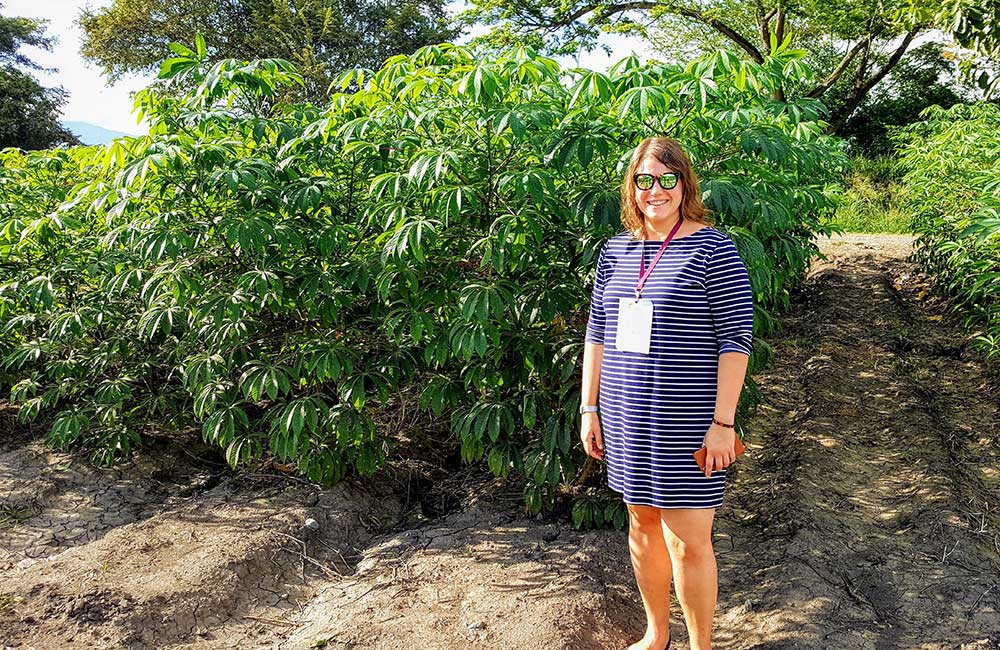IGI researchers are using CRISPR to alter the staple crop cassava, making it safer and easier to eat.
Michael Gomez grew up eating cassava with his Colombian family. Now he’s editing its genes.
“I knew it as ‘yuca’ growing up. It was a big part of our diet. When I had a chance to work on a crop that I would consume regularly with family, I thought it was an awesome opportunity,” says Gomez, a postdoc in the Staskawicz Lab at IGI.
Cassava goes by many names: yuca, manioc, muhogo, tapioca. Starch from the tuberous roots of cassava make the chewy pearls in boba tea, the blobs in tapioca pudding, and it’s found in a wide variety of gluten-free products. Worldwide, it’s one of the most important root crops.
“Roughly a billion people around the world rely on cassava as a source of calories, including around 40 percent of Africans. Cassava isn’t really a staple in the US, but in many parts of the world, particularly in the tropics, it’s an incredibly important crop,” says Jessica Lyons, principal investigator of this cassava genome editing project at IGI.
Cassava is important, but it also comes with a built-in problem that inspired the IGI team to work on it: cyanide. Cassava roots naturally produce the precursor of cyanide. Over time, consuming cyanide can have effects that range from subtle cognitive problems to konzo, a severe disease characterized by sudden and irreversible paralysis of the legs.
Proper processing can remove cyanide from cassava, but many people are eating insufficiently processed cassava. This is a problem particularly in parts of sub-Saharan Africa that have experienced drought, famine, and instability. The effects of the toxicity are worse in places where people don’t have easy access to protein in their diets, which helps detoxify cyanide and mitigates its effects.
Beyond the health impacts, the processing necessary to remove the cyanide from cassava is a burden that mainly falls on women. Industrial processing is both energy intensive and produces cyanide-laced wastewater.
“If we’re able to prevent cyanide production to begin with, it could make processing so much faster and easier for families and primarily the women who do the work,” says Lyons.
Genome Editing in Cassava
To make cyanide-free cassava a reality, Lyons, Gomez, and the team of researchers at the IGI are using CRISPR genome editing to block the production of cyanide.
“We first applied CRISPR to engineer resistance to a problematic disease on the east coast of Africa called cassava brown streak disease, in collaboration with the Danforth Plant Science Center in St. Louis, Missouri,” says Gomez. “We used CRISPR to target two specific genes, and showed a reduction in severity and incidence of symptoms.”
“When you do make a cross, it’s like throwing all the traits, both good and bad, up into the air and you can’t control what you get… CRISPR is much, much quicker than conventional breeding, and it’s precise.”
Moving onto cyanide was a logical next step for the IGI team and collaborators at the Danforth Center. The biosynthetic pathway of cyanide in cassava was already well understood, which provided a road map for genome editing. In addition, other researchers showed that it was possible to interfere with this pathway using a technique known as RNA interference (RNAi) and measurably reduce the cyanide levels.
“Genome editing is cleaner than RNAi. It provides a complete knockdown and makes a change in the genome that’s both stable and heritable,” says Lyons.

Conventional breeding techniques could, in theory, remove cyanide — though it has yet to happen in over 7000 years of domestication. One challenge to breeding undesired traits out of cassava is that it is typically grown from stem cuttings, producing clones of the parent plant. The conventional approach involves cross-breeding plants with desirable characteristics and growing the offspring from seed.
“Cassava breeding takes a long time, and the plants don’t always flower at the same time. When you do make a cross, it’s like throwing all the traits, both good and bad, up into the air and you can’t control what you get in the offspring. CRISPR is much, much quicker than conventional breeding, and it’s precise,” says Lyons.
What’s Next for Cassava
When the IGI team discuss their cassava work, they’re often asked one key question: Does the cyanide in cassava serve a purpose?
“It may play a role in anti-herbivory, deterring some insects and animals. However, many pests have evolved to tolerate this toxin with some even being attracted to it. How important is it for pest resistance? By knocking out the pathway, we now have a way to scientifically study the role that cyanide plays,” says Gomez.
It will still be some time before a cyanide-free cassava variety is available for farmers. First, field studies will be needed with partnering organizations in Africa, and the research isn’t stopping at just one variety.
“Farmers in different parts of the world may choose to grow one variety over another due to taste, early maturity, high yields, and more. We’d like to preserve that diversity,” says Lyons. “What’s so beautiful about genome editing is that we can develop the method and then apply it to other varieties. We’re creating the platform, and then we can expand to other varieties that farmers prefer.”
Thanks to CropLife International and the American Seed Trade Association for profiling this research in the video above.
RELATED INFORMATION